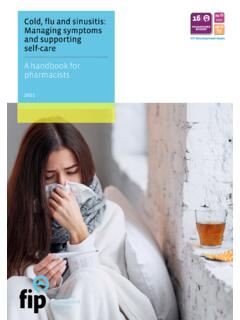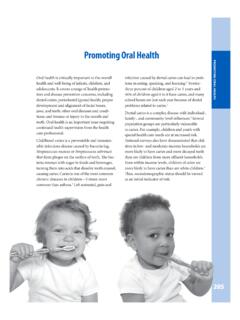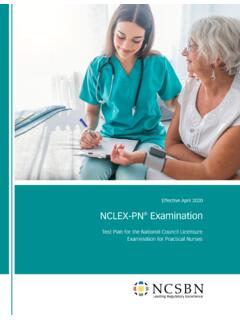Transcription of NHS RightCare: Frailty Toolkit
1 nhs rightcare : Frailty Toolkit Optimising a Frailty system Increasing numbers of people are at risk of developing Frailty . People living with Frailty are experiencing unwarranted variation in their care . This Toolkit will provide you with expert practical advice and guidance on how to commission and provide the best June 2019. system wide care for people living with Frailty . Gateway ref: 000513. Informed by relevant NICE. recommendations Summary nhs rightcare Frailty Toolkit System improvement priorities: This nhs rightcare system Toolkit will support systems to understand the priorities in Frailty care and key actions to take. It provides a way to assess and benchmark current systems to find Population segmentation, opportunities for improvement. It is produced with reference to an expert group of stakeholders identification and stratification and is supported by NICE.
2 Wider consultation has taken place with patient representatives, Supporting people living with clinicians, social care organisations, professional bodies and other key stakeholders. mild Frailty and encouraging people to age well' The national challenges: Supporting people living with Increasing numbers of people are at risk of developing Frailty . A person living with mild Frailty moderate Frailty has twice the mortality risk of a fit older person. More people living with mild, moderate or severe Frailty are attending emergency Supporting people living with severe Frailty departments, with over 4000 admissions daily for people living with Frailty . Older people living with mild, moderate or severe Frailty are more likely to have delayed Reducing hospital length transfers of care . 45% of people experiencing delayed transfers of care are over 85.
3 Of stay (approximately 50% of people aged 85 and over will encounter Frailty ). Falls and fragility fractures People living with mild, moderate or severe Frailty could often have their needs met best in settings outside of acute hospital care . Severe Frailty often brings over four times the costs of Delirium, dementia and non- Frailty . cognitive disorder The national nhs rightcare opportunity Personalised care 29,000 fewer injuries due to falls in people 25,000 fewer long stay patients aged 85 or aged 65 or over if CCGs achieved the rate of over if CCGs achieved the rate of their lowest Experience of care their lowest five peers. five peers. Guidance and best practice Links to other nhs rightcare products nhs rightcare has a comprehensive Frailty support offer which includes: self -assessment nhs rightcare Frailty Focus Pack: This provides each CCG in England with the most questionnaire relevant Frailty data, compared to their most similar ten CCGs.
4 To access please contact your local Delivery Partner. Additional nhs rightcare Frailty products nhs rightcare Frailty Scenario: This provides Janet's story of living with Frailty in a sub- optimal pathway compared to an optimal pathway. Summary This nhs rightcare Toolkit supports the delivery of the System improvement NHS Long Term Plan for Frailty : priorities: Population segmentation, The NHS Long Term Plan sets out an evidence-based framework of care for older identification and stratification people with Frailty to be delivered through the national Ageing Well programme. This focuses on delivering integrated personalised care in communities and Supporting people living with mild Frailty and encouraging addresses the needs of older people with three inter-related service models people to age well' centred on clearly identifiable patient cohorts: Supporting people living with 1) Community multidisciplinary teams -targets the moderate Frailty moderate Frailty population10, people whose annual risk of urgent care utilisation, death and Supporting people living care home admission is 3 times that of an older person of the same age who is with severe Frailty fit.
5 This group are considered to be the most amenable to targeted proactive Reducing hospital length interventions to reduce Frailty progression and unwarranted secondary care of stay utilisation. Falls and fragility fractures 2) Urgent Community Response crisis response and community recovery for Delirium, dementia and older people who are at risk of unwarranted stay in hospital admission and cognitive disorder whose needs can be met more effectively in a community setting. Personalised care 3) Enhanced health in care homes for which there is not a consistent health care support offer across England despite care home beds outnumbering NHS. Experience of care hospital beds by 3:1 and being an increasingly important place for end of life care ;. Guidance and best practice The Ageing Well programme and framework aim to support commissioners and self -assessment providers of acute and community health services, social care and the voluntary questionnaire sector to work together, turning what is currently urgent care into planned care for key groups of vulnerable older people.
6 Additional nhs rightcare Frailty products Professor Martin J Vernon, National Clinical Director for Older People and Person Centred Integrated care nhs rightcare Frailty Toolkit : System improvement priorities Population segmentation, identification and stratification Falls and fragility of Frailty fractures Supporting people living with mild Frailty and encouraging Delirium, dementia and people to age well' cognitive disorder Supporting people living with moderate Frailty Personalised care Supporting people living with severe Frailty Experience of care Reducing hospital self -assessment length of stay questionnaire Summary System improvement priority: Population segmentation, identification and stratification of System improvement priorities: Frailty Population segmentation, Segmentation, identification and stratification of the population living with Frailty by needs and not identification and stratification age is essential.
7 This allows use across health and social care , that can support joint priorities, Supporting people living with and integrated and personalised care . This part of the Toolkit contains support for commissioners mild Frailty and encouraging and providers of health and social care across the system in all settings; from care homes to people to age well' primary care to hospital care . Supporting people living with moderate Frailty Key areas for focus: Supporting people living System wide recognition of the signs of Frailty with severe Frailty Everyone in a system who could encounter people living with Frailty knows Guidance what the signs are. This includes health and social care workers, family, and best Reducing hospital length practice of stay carers, emergency services, and voluntary sector workers. Falls and fragility fractures Know what to do when signs of Frailty are found It is critically important that when signs of Frailty are suspected that people Guidance Delirium, dementia and know what to do.
8 This is important in a variety of settings, from emergency and best cognitive disorder practice departments to community exercise classes to patients' homes. Actions to take Personalised care Standardised way of stratifying Frailty Having a strategy to consistently stratify Frailty is key to an organised Guidance Experience of care system. The GP contract supports the use of a standardised approach to and best Frailty stratification and population segmentation. This could be done practice Guidance and best practice through the electronic Frailty index (eFI). self -assessment Identify Frailty and Frailty risk questionnaire Ensure that when appropriately trained health and care staff suspect Frailty , Guidance that they can then undertake an individual Frailty score to identify Frailty and best Additional nhs rightcare practice status.
9 Using tools such as the PRISMA-7 questionnaire. Frailty products Summary System improvement priority: Population segmentation, identification and stratification of System improvement priorities: Frailty Population segmentation, Actions to take: identification and stratification Have a network of Frailty champions' or a Frailty forum' identified, with a role in Supporting people living with promoting a consistent and universal awareness and understanding of Frailty . mild Frailty and encouraging System wide Take a systematic approach to promoting the awareness and understanding of people to age well' recognition of Frailty with individuals, carers, families and partners in health, care , voluntary Supporting people living with the signs of sector and wider public services. moderate Frailty Frailty Align understanding of Frailty to the Frailty Core Capabilities Framework's Supporting people living Domain A, Understanding, identifying and assessing Frailty '.
10 With severe Frailty Use a systematic approach to identifying which people living with Frailty are most Reducing hospital length Know what to at risk and are therefore most likely to benefit from a comprehensive geriatric of stay do when signs assessment (CGA) or targeting CGA to those most likely to benefit. of Frailty are Communicate across the system the outcome of a CGA and associated action Falls and fragility fractures plan. found Delirium, dementia and Do you have a universal referral process? How do services refer to each other? cognitive disorder Use an appropriate risk stratification or population segmentation tool such as the Standardised electronic Frailty index (eFI) in accordance with the GP contract. Personalised care way of Ensure clinical correlation of eFI results is undertaken. stratifying Consider implications of resource modelling based on stratification of Frailty Experience of care Frailty population.

















